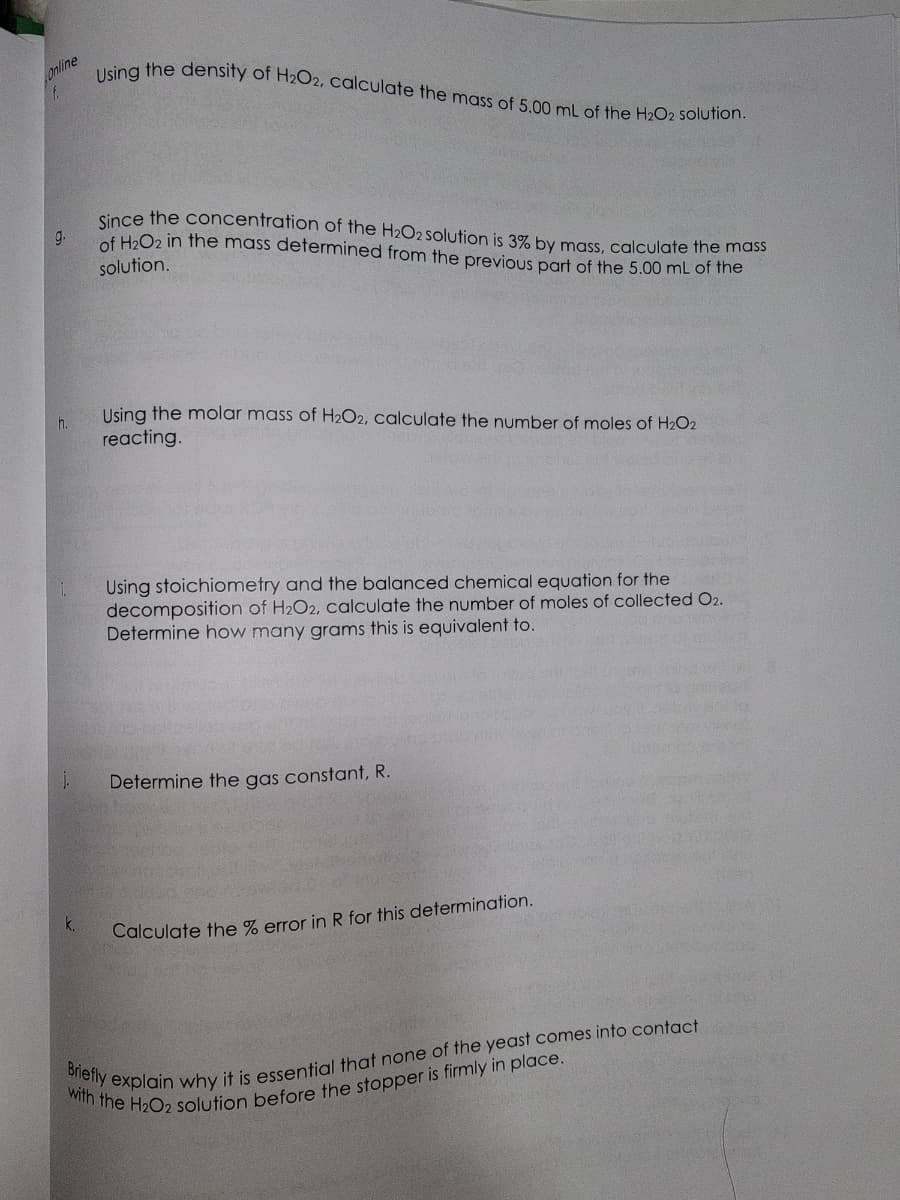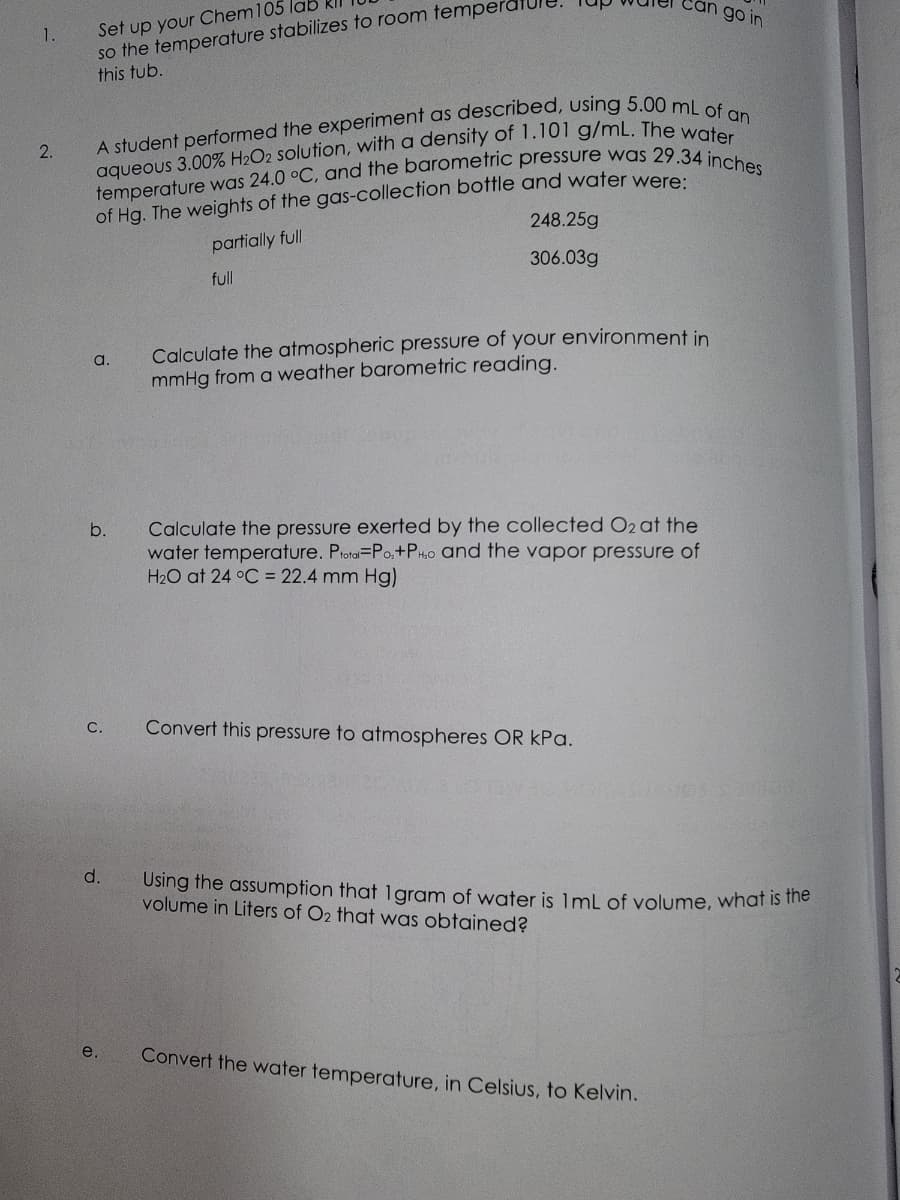2. A student performed the experiment as described, using 5.00 mL of an aqueous 3.00% H2O2 solution, with a density of 1.101 g/mL. The water temperature was 24.0 °C, and the barometric pressure was 29.34 inches of Hg. The weights of the gas-collection bottle and water were: 248.25g partially full full 306.03g a. b. C. d. e. Calculate the atmospheric pressure of your environment in mmHg from a weather barometric reading. Calculate the pressure exerted by the collected O2 at the water temperature. Ptotal Po,+PH₂o and the vapor pressure of H₂O at 24 °C = 22.4 mm Hg) Convert this pressure to atmospheres OR kPa. Using the assumption that 1gram of water is 1mL of volume, what is the volume in Liters of O2 that was obtained? Convert the water temperature, in Celsius, to Kelvin.
2. A student performed the experiment as described, using 5.00 mL of an aqueous 3.00% H2O2 solution, with a density of 1.101 g/mL. The water temperature was 24.0 °C, and the barometric pressure was 29.34 inches of Hg. The weights of the gas-collection bottle and water were: 248.25g partially full full 306.03g a. b. C. d. e. Calculate the atmospheric pressure of your environment in mmHg from a weather barometric reading. Calculate the pressure exerted by the collected O2 at the water temperature. Ptotal Po,+PH₂o and the vapor pressure of H₂O at 24 °C = 22.4 mm Hg) Convert this pressure to atmospheres OR kPa. Using the assumption that 1gram of water is 1mL of volume, what is the volume in Liters of O2 that was obtained? Convert the water temperature, in Celsius, to Kelvin.
Chemistry
10th Edition
ISBN:9781305957404
Author:Steven S. Zumdahl, Susan A. Zumdahl, Donald J. DeCoste
Publisher:Steven S. Zumdahl, Susan A. Zumdahl, Donald J. DeCoste
Chapter1: Chemical Foundations
Section: Chapter Questions
Problem 1RQ: Define and explain the differences between the following terms. a. law and theory b. theory and...
Related questions
Question
Please help with question 2 d, e, and f

Transcribed Image Text:Online
f.
g.
h.
k.
Using the density of H2O2, calculate the mass of 5.00 mL of the H₂O2 solution.
Since the concentration of the H₂O2 solution is 3% by mass, calculate the mass
of H₂O2 in the mass determined from the previous part of the 5.00 mL of the
solution.
Using the molar mass of H₂O2, calculate the number of moles of H₂O2
reacting.
Using stoichiometry and the balanced chemical equation for the
decomposition of H₂O2, calculate the number of moles of collected O2.
Determine how many grams this is equivalent to.
Determine the gas constant, R.
Calculate the % error in R for this determination.
Briefly explain why it is essential that none of the yeast comes into contact
with the H₂O2 solution before the stopper is firmly in place.

Transcribed Image Text:1.
2.
Set up your Chem 105 lab
so the temperature stabilizes to room temperd
this tub.
A student performed the experiment as described, using 5.00 mL of an
aqueous 3.00% H₂O2 solution, with a density of 1.101 g/mL. The water
temperature was 24.0 °C, and the barometric pressure was 29.34 inches
of Hg. The weights of the gas-collection bottle and water were:
248.25g
partially full
full
306.03g
a.
b.
C.
d.
e.
Calculate the atmospheric pressure of your environment in
mmHg from a weather barometric reading.
1710
can go in
Calculate the pressure exerted by the collected O2 at the
water temperature. Ptotal-Po₂+PH₂o and the vapor pressure of
H₂O at 24 °C = 22.4 mm Hg)
Convert this pressure to atmospheres OR kPa.
Using the assumption that 1 gram of water is 1mL of volume, what is the
volume in Liters of O2 that was obtained?
Convert the water temperature, in Celsius, to Kelvin.
Expert Solution
This question has been solved!
Explore an expertly crafted, step-by-step solution for a thorough understanding of key concepts.
This is a popular solution!
Trending now
This is a popular solution!
Step by step
Solved in 3 steps with 3 images

Knowledge Booster
Learn more about
Need a deep-dive on the concept behind this application? Look no further. Learn more about this topic, chemistry and related others by exploring similar questions and additional content below.Recommended textbooks for you

Chemistry
Chemistry
ISBN:
9781305957404
Author:
Steven S. Zumdahl, Susan A. Zumdahl, Donald J. DeCoste
Publisher:
Cengage Learning

Chemistry
Chemistry
ISBN:
9781259911156
Author:
Raymond Chang Dr., Jason Overby Professor
Publisher:
McGraw-Hill Education

Principles of Instrumental Analysis
Chemistry
ISBN:
9781305577213
Author:
Douglas A. Skoog, F. James Holler, Stanley R. Crouch
Publisher:
Cengage Learning

Chemistry
Chemistry
ISBN:
9781305957404
Author:
Steven S. Zumdahl, Susan A. Zumdahl, Donald J. DeCoste
Publisher:
Cengage Learning

Chemistry
Chemistry
ISBN:
9781259911156
Author:
Raymond Chang Dr., Jason Overby Professor
Publisher:
McGraw-Hill Education

Principles of Instrumental Analysis
Chemistry
ISBN:
9781305577213
Author:
Douglas A. Skoog, F. James Holler, Stanley R. Crouch
Publisher:
Cengage Learning

Organic Chemistry
Chemistry
ISBN:
9780078021558
Author:
Janice Gorzynski Smith Dr.
Publisher:
McGraw-Hill Education

Chemistry: Principles and Reactions
Chemistry
ISBN:
9781305079373
Author:
William L. Masterton, Cecile N. Hurley
Publisher:
Cengage Learning

Elementary Principles of Chemical Processes, Bind…
Chemistry
ISBN:
9781118431221
Author:
Richard M. Felder, Ronald W. Rousseau, Lisa G. Bullard
Publisher:
WILEY